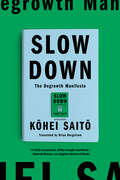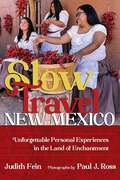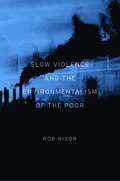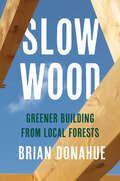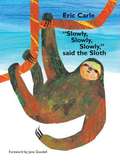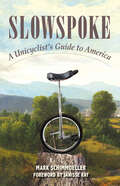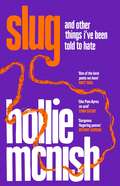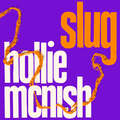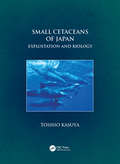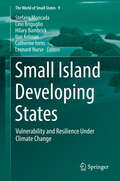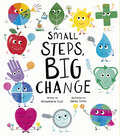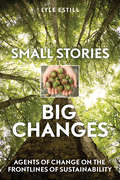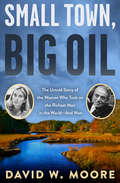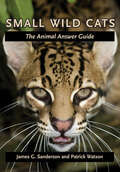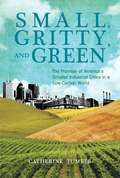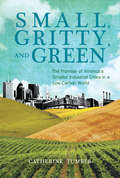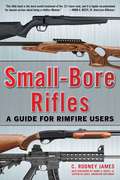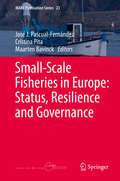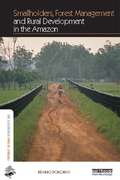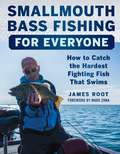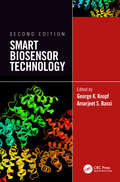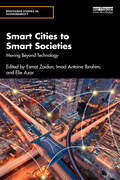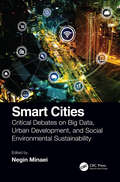- Table View
- List View
Slow Down: The Degrowth Manifesto
by KOHEI SAITO"[A] well-reasoned and eye-opening treatise . . . [Kohei Saito makes] a provocative and visionary proposal." —Publishers Weekly, (starred review)"Saito&’s clarity of thought, plethora of evidence, and conversational, gentle, yet urgent tone . . . are sure to win over open-minded readers who understand the dire nature of our global. . . . A cogently structured anti-capitalist approach to the climate crisis." —Kirkus Reviews (starred review)Why, in our affluent society, do so many people live in poverty, without access to health care, working multiple jobs and are nevertheless unable to make ends meet, with no future prospects, while the planet is burning?In his international bestseller, Kohei Saito argues that while unfettered capitalism is often blamed for inequality and climate change, subsequent calls for &“sustainable growth&” and a &“Green New Deal&” are a dangerous compromise. Capitalism creates artificial scarcity by pursuing profit based on the value of products rather than their usefulness and by putting perpetual growth above all else. It is therefore impossible to reverse climate change in a capitalist society—more: the system that caused the problem in the first place cannot be an integral part of the solution. Instead, Saito advocates for degrowth and deceleration, which he conceives as the slowing of economic activity through the democratic reform of labor and production. In practical terms, he argues for:the end of mass production and mass consumptiondecarbonization through shorter working hours the prioritization of essential labor over corporate profitsBy returning to a system of social ownership, he argues, we can restore abundance and focus on those activities that are essential for human life, effectively reversing climate change and saving the planet.
Slow Travel New Mexico: Unforgettable Personal Experiences in the Land of Enchantment (Southwest Adventure Series)
by Judith FeinWinner of the 2024 New Mexico-Arizona Book Award for TravelSlow travel is the secret to opening doors, meeting people, participating in surprising events, experiencing joy, and making each trip--no matter how short or long--deeper, richer, and an adventure that is uniquely yours.Award-winning travel journalists and Santa Fe residents Judith Fein and Paul J. Ross crisscross New Mexico, finding unforgettable adventures readers can personally experience such as painting with an abstract artist on the Navajo Reservation, visiting a wolf refuge, cruising in a lowrider, hiking in a volcano, gourmet dining at Zuni Pueblo, seeing a ghost, tracking the true Billy the Kid . . . and so much more.Slow Travel New Mexico is an invitation to show up in a place and let it reveal itself to you--on its own terms. It's not about going off the beaten path. It's about going off the beaten mental path by learning to look, see, open up, and explore differently. It's a guide to unforgettable experiences.
Slow Violence and the Environmentalism of the Poor
by Rob Nixon“Slow violence” from climate change, toxic drift, deforestation, oil spills, and the environmental aftermath of war takes place gradually and often invisibly. Rob Nixon focuses on the inattention we have paid to the lethality of many environmental crises, in contrast with the sensational, spectacle-driven messaging that impels public activism today.
Slow Wood: Greener Building from Local Forests (Yale Agrarian Studies Series)
by Brian DonahueA radical proposal for healing the relationship between humans and forests through responsible, sustainable use of local and regional wood in home building American homes are typically made of lumber and plywood delivered by a global system of ruthless extraction, or of concrete and steel, which are even worse for the planet. Wood is often the most sustainable material for building, but we need to protect diverse forests as much as we desperately need more houses. Brian Donahue addresses this modern conundrum by documenting his experiences building a timber frame home from the wood growing on his family farm, practicing &“worst first&” forestry. Through the stories of the trees he used (sugar maple, black cherry, black birch, and hemlock), and some he didn&’t (white pine and red oak), the book also explores the history of Americans&’ relationship with their forests. Donahue provides a new interpretation of the connection between American houses and local woodlands. He delves into how this bond was broken by the rise of a market economy of industrial resource extraction and addresses the challenge of restoring a more enduring relationship. Ultimately, this book provides a blueprint and a stewardship plan for how to live more responsibly with the woods, offering a sustainable approach to both forestry and building centered on tightly connected ecological and social values.
Slowly Slowly Slowly Said the Sloth
by Eric CarleSlowly, slowly, slowly . . . that's how the sloth lives. He hangs upside-down from the branch of a tree, night and day, in the sun and in the rain, while the other animals of the rain forest rush past him. "Why are you so slow? Why are you so quiet? Why are you so lazy?" the others ask the sloth. And, after a long, long, long time, the sloth finally tells them! Set in the lush world of the tropical rain forest, this original picture book is an exquisite showcase of Eric Carle's colorful collage art-with a meaningful message: Slow down! Take time to enjoy your world.
Slowspoke: A Unicyclist's Guide to America
by Mark SchimmoellerWhy a unicycle? Why a cross-country trip? Why leave a prominent New York magazine and return to the simple life in Kentucky?Reminiscent of classic literary travelogues, Mark Schimmoeller&’s Slowspoke: A Unicyclist&’s Guide to America takes readers on an inward, emotional journey as he inches across landscapes and communities from North Carolina to Arizona.Schimmoeller became inspired by his unicycle as an adolescent. It taught him that rushing—whether down the driveway or toward adulthood—would cause a fall, and so, instead of accepting the speeding, straight line that de-fines modern American life, he adopted his single wheel&’s wayward rhythms.Written with poise and humor, Slowspoke is more than a cross-country trip on a unicycle; it&’s a meditation on a playful, recalcitrant slowness that is increasingly rare in a culture obsessed with acceleration. At times ach-ing and other times joyful, Schimmoeller intersperses recollections of his journey with vignettes of his present-day, off-the-grid homesteading with his wife in Kentucky and their efforts to save an old-growth forest.Schimmoeller&’s personal journey will resonate with anyone who has slowed down to experience life at a unicycle&’s speed or who longs to do so, who has fallen in love or searched for it, or who has treasured tall trees or mourned their loss.
Slug: The Sunday Times Bestseller
by Hollie McNishTHE SUNDAY TIMES BESTSELLER'An intoxicating mixture of poetry and prose, Slug is a taboo-busting delight' SCOTSMAN 'One of the best poets we have' MATT HAIG 'She writes with honesty, conviction, humour and love' KAE TEMPESTThe new collection of poetry and prose from the Ted Hughes Award-winning author of Nobody Told MeFrom Finnish saunas and soppy otters to grief, grandparents and Kellogg's anti-masturbation pants, Slug is a book which holds a mirror lovingly up to the world, past and present, through Hollie's driving, funny, hopeful poetry and prose. Slug is about the human condition: of birth and death and how we manage the possibilities in between.'The inimitable words of poet/goddess Hollie McNish once again hold up honest, damn funny and refreshing takes on the everydayness of our lives . . . Never have we needed her more' STYLIST'Hollie always articulates exactly how I feel' CHARLY COX'A tribute to life itself' RED
Slug: The Sunday Times Bestseller
by Hollie McNishTHE SUNDAY TIMES BESTSELLER'An intoxicating mixture of poetry and prose, Slug is a taboo-busting delight' SCOTSMAN 'One of the best poets we have' MATT HAIG 'She writes with honesty, conviction, humour and love' KAE TEMPESTThe new collection of poetry and prose from the Ted Hughes Award-winning author of Nobody Told MeFrom Finnish saunas and soppy otters to grief, grandparents and Kellogg's anti-masturbation pants, Slug is a book which holds a mirror lovingly up to the world, past and present, through Hollie's driving, funny, hopeful poetry and prose. Slug is about the human condition: of birth and death and how we manage the possibilities in between.'The inimitable words of poet/goddess Hollie McNish once again hold up honest, damn funny and refreshing takes on the everydayness of our lives . . . Never have we needed her more' STYLIST'Hollie always articulates exactly how I feel' CHARLY COX'A tribute to life itself' RED
Slug: The Sunday Times Bestseller
by Hollie McNishListen to the audiobook for an exclusive interview with Hollie and her good friend, radio presenter Gemma Cairney. Hollie has also included a special poetry reading in memory of her grandmother, as well as an exclusive preview of poems from her next book.'One of the best poets we have' MATT HAIG'She writes with honesty, conviction, humour and love' KAE TEMPEST 'Hollie always articulates exactly how I feel' CHARLY COX The new collection of poetry and prose from the Ted Hughes Award-winning author of Nobody Told MeFrom Finnish saunas and soppy otters to grief, grandparents and Kellogg's anti-masturbation pants, Slug is a book which holds a mirror lovingly up to the world, past and present, through Hollie's driving, funny, hopeful poetry and prose. Slug is about the human condition: of birth and death and how we manage the possibilities in between.'The inimitable words of poet/goddess Hollie McNish once again hold up honest, damn funny and refreshing takes on the everydayness of our lives . . . Never have we needed her more' STYLIST
Small Cetaceans of Japan: Exploitation and Biology
by Toshio KasuyaThis book summarizes and analyzes the biology, ecology, exploitation and management of small cetaceans in Japan. It describes the various types of cetacean fisheries in Japan and their historical development, the life histories and ecologies of the main species involved, and the history and problems of conservation and management. The data show that in some cases the number of small cetaceans harvested exceed sustainable limits and have led to depletion of populations. The book provides a case study of what can go wrong when the needs of industry and conservation collide. The descriptions of life history and ecology are relevant to issues of conservation and management, not just for cetaceans, but for all fisheries around the world.
Small Island Developing States: Vulnerability and Resilience Under Climate Change (The World of Small States #9)
by Ilan Kelman Lino Briguglio Stefano Moncada Hilary Bambrick Catherine Iorns Leonard NurseThis book explores how vulnerable and resilient communities from SIDS are affected by climate change; proposes and, where possible, evaluates adaptation activities; identifies factors capable of enhancing or inhibiting SIDS people’s long-term ability to deal with climate change; and critiques the discourses, vocabularies, and constructions around SIDS dealing with climate change. The contributions, written by well-established scholars, as well as emerging authors and practitioners, in the field, include conceptual papers, coherent methodological approaches, and case studies from the communities based in the Caribbean Sea and the Indian, Atlantic, and Pacific Oceans. In their introduction, the editors contextualise the book within the current literature. They emphasise the importance of stronger links between climate change science and policy in SIDS, both to increase effectiveness of policy and also boost scholarly enquiry in the context of whose communities are often excluded by mainstream research. This book is timely and appropriate, given the recent commission by the Intergovernmental Panel on Climate Change (IPCC) of a Special Report that aims at addressing vulnerabilities, “especially in islands and coastal areas, as well as the adaptation and policy development opportunities” following the Paris Agreement. Coupled with this, there is also the need to support the policy community with further scientific evidence on climate change–related issues in SIDS, accompanying the first years of implementation of the United Nations Sustainable Development Goals.
Small Steps, Big Change
by Annemarie CoolAn uplifting, environmental picture book guide for kids ages 3-7 with 14 simple tips for helping to build a better tomorrow, inspired by the United Nations Sustainable Development Goals.Children ages 3-7 will meet Water Hero, Sharing Hero, and more fun characters as they present 14 simple tips that everyone can do to make our world a better place.Everyone can make a difference when it comes to protecting the environment! This inviting book is full of 14 simple, everyday goals that anyone can achieve to bring about positive change.Tips include:Keeping ourselves healthy by eating vegetables and getting plenty of exercise; Using reusable bags for shopping and conserving energy and water;Reducing the amount of plastic we use and keeping beaches clean when we visit them; andTreating others with respect and working togetherInspired by the Sustainable Development Goals, formulated by the United Nations.
Small Stories, Big Changes: Agents of Change on the Frontlines of Sustainability
by David W. Orr Lyle EstillA remarkable cast of characters inhabit the pages of this book. Meet Tim Toben, who developed a high rise with the lowest energy consumption of any building in the southeastern United States, was foreclosed upon, and lost millions in the process. Gary Phillips held the line against real estate developers in Chatham County and was run out of office for his efforts. Elaine Chiosso has been protecting her watershed by fighting on behalf of the Haw River for twenty-eight years.Unflinchingly honest and compulsively readable, Small Stories, Big Changes provides an intimate look at the personal experience of being a pioneer in the sustainability movement, laying bare the emotional, spiritual, and financial impact of a life lived in the service of change. Activist, farmer, publisher, philosopher or entrepreneur; each writer has a unique personal tale to tell.Small Stories, Big Changes is a book written by ordinary people doing extraordinary things; whose lives have been transformed by their willingness to commit themselves unreservedly to the creation of a better world. Empowering, hopeful, and inspiring, this rich tapestry of voices from the vanguard of change is a must-read for anyone dreaming of a brighter future and seeking a counterbalance to a canon of work that is laced with doom and gloom.Lyle Estill is the president and co-founder of Piedmont Biofuels and the author of Industrial Evolution, Small is Possible, and Biodiesel Power. He has won numerous awards for his commitment to sustainability, outreach, community development, and leadership.
Small Town, Big Oil: The Untold Story of the Women Who Took on the Richest Man in the World—and Won
by David W. MooreHow three New Hampshire women triumphed over an oil billionaire: &“A very timely reminder that when we fight we often win.&”—Bill McKibben Never underestimate the underdog. In 1973, Greek oil shipping magnate Aristotle Onassis—husband of President John F. Kennedy&’s widow, Jacqueline, and arguably the richest man in the world—proposed to build an oil refinery on the narrow New Hampshire coast, in the town of Durham. At the time, it would have cost $600 million to build and was expected to generate 400,000 barrels of oil per day, making it the largest oil refinery in the world. The project was vigorously supported by the governor, Meldrim Thomson, and by William Loeb, the notorious publisher of the only statewide newspaper, the Manchester Union Leader. But three women vehemently opposed the project—Nancy Sandberg, the town leader who founded and headed Save Our Shores; Dudley Dudley, the freshman state rep who took the fight to the state legislature; and Phyllis Bennett, the publisher of the local newspaper that alerted the public to Onassis&’ secret acquisition of the land. Small Town, Big Oil is the story of how the residents of Durham, led by these three women, out-organized, out-witted, and out-maneuvered the governor, the media, and the Onassis cartel to hand the powerful Greek billionaire the most humiliating defeat of his business career, and spare the New Hampshire seacoast from becoming an industrial wasteland. &“Activists and organizers will find lots of ideas and inspirations in this book's detailed account of an epic battle.&”—Bill McKibben &“[An] apt handbook on the power of the people.&”—Providence Journal
Small Wild Cats: The Animal Answer Guide (The Animal Answer Guides: Q&A for the Curious Naturalist)
by Patrick Watson James G. SandersonDid you know that most wild cat species are small and that lions, tigers, and other large cats are the exception? That adult bobcats, clouded leopards, and other small wild cats are completely asocial? And that they fight only as a last resort? This entertaining and informative book reveals these and hundreds of other facts about the behavior, biology, and conservation of the more than 30 small wild cat species. From bobcats to servals, small cats are spread across the globe. They range in size from the rusty-spotted cat and African black-footed cat, each of which weighs around 5 pounds when fully grown, to the Eurasian lynx, which can reach an adult weight of 60 pounds. These felids are elusive, some are nocturnal, others are arboreal, and all are rare and secretive, making them especially difficult to study. James G. Sanderson, the world’s leading field expert on small wild cats, and naturalist and wildlife artist Patrick Watson provide informative and entertaining answers to common and unexpected questions about these animals. The authors explain why some small cats live on the ground while others inhabit trees, discuss the form and function of their coat types and colors, offer scientifically sound information on human–small wild cat interactions, and even review the role that small wild cats have played in literature, religion, and mythology. The world of cats is as fascinating as it is diverse. Small Wild Cats: The Animal Answer Guide shows just how important and interesting the littlest of the nondomesticated feline family are.
Small, Gritty, and Green
by Catherine TumberAmerica's once-vibrant small-to-midsize cities--Syracuse, Worcester, Akron, Flint, Rockford, and others--increasingly resemble urban wastelands. Gutted by deindustrialization, outsourcing, and middle-class flight, disproportionately devastated by metro freeway systems that laid waste to the urban fabric and displaced the working poor, and struggling with pockets of poverty reminiscent of postcolonial squalor, small industrial cities--as a class--have become invisible to a public distracted by the Wall Street (big city) versus Main Street (small town) matchup. These cities would seem to be part of America's past, not its future. And yet, journalist and historian Catherine Tumber argues in this provocative book, America's gritty Rust Belt cities could play a central role in a greener, low-carbon, relocalized future. As we wean ourselves from fossil fuels and realize the environmental costs of suburban sprawl, we will see that small cities offer many assets for sustainable living not shared by their big city or small town counterparts: population density (and the capacity for more); fertile, nearby farmland available for local agriculture, windmills, and solar farms; and manufacturing infrastructure and workforce skill that can be repurposed for the production of renewable technology. Tumber, who has spent much of her life in Rust Belt cities, traveled to twenty-five cities in the Northeast and Midwest--from Buffalo to Peoria to Detroit to Rochester--interviewing planners, city officials, and activists, and weaving their stories into this exploration of small-scale urbanism. Smaller cities can be a critical part of a sustainable future and a productive green economy. Small, Gritty, and Green will help us develop the moral and political imagination we need to realize this.
Small, Gritty, and Green: The Promise of America's Smaller Industrial Cities in a Low-Carbon World (Urban and Industrial Environments)
by Catherine TumberHow small-to-midsize Rust Belt cities can play a crucial role in a low-carbon, sustainable, and relocalized future.America's once-vibrant small-to-midsize cities—Syracuse, Worcester, Akron, Flint, Rockford, and others—increasingly resemble urban wastelands. Gutted by deindustrialization, outsourcing, and middle-class flight, disproportionately devastated by metro freeway systems that laid waste to the urban fabric and displaced the working poor, small industrial cities seem to be part of America's past, not its future. And yet, Catherine Tumber argues in this provocative book, America's gritty Rust Belt cities could play a central role in a greener, low-carbon, relocalized future.As we wean ourselves from fossil fuels and realize the environmental costs of suburban sprawl, we will see that small cities offer many assets for sustainable living not shared by their big city or small town counterparts, including population density and nearby, fertile farmland available for new environmentally friendly uses.Tumber traveled to twenty-five cities in the Northeast and Midwest—from Buffalo to Peoria to Detroit to Rochester—interviewing planners, city officials, and activists, and weaving their stories into this exploration of small-scale urbanism. Smaller cities can be a critical part of a sustainable future and a productive green economy. Small, Gritty, and Green will help us develop the moral and political imagination we need to realize this.
Small-Bore Rifles: A Guide for Rimfire Users
by C. Rodney James Mark A. KeefeC. Rodney James provides a starting point for the beginner as well as a current summary of the state of small-bore rifles, ammunition, and shooting for intermediate shooters. Small-Bore Rimfire Rifles also points the way for those who want to venture into the more rarefied regions of upper-level competitive, benchrest, and long-range varmint shooting, plus that eternal search for the perfect rifle. James packs his book with tested tips, tactics, and techniques for small-bore rimfires, such as: Small-bore rimfire ammunition Choosing a rifle Semiauto and bolt-action rifles Accurate shooting Cleaning, maintenance, and care Range, lethality, and performance Hunting and varmint shooting Modern competitive shooting And much more! Small-bore rifle shooting has and will continue to provide millions with endless hours of enjoyment on the range and in the field. Pick up Small-Bore Rimfire Rifles today.
Small-Scale Fisheries in Europe: Status, Resilience and Governance (MARE Publication Series #23)
by Maarten Bavinck José J. Pascual-Fernández Cristina PitaThis book offers a comprehensive account of the status and dynamics of people participating in the small-scale fisheries (SSF) of Europe. It covers the situation of SSF in 25 coastal countries, thereby providing a portrait of almost every coastal country on the continent and analyzing the recent evolution of the sector. Small-scale fisheries are argued to be extremely important in Europe, as they provide employment and welfare, while increasing food sovereignty and maintaining communities in coastal areas. The recent worldwide focus on SSF derives from their environmental sustainability, which distinguishes many of their activities from those of large-scale fisheries. This book analyses the diversity of SSF and shows how fishing communities have sometimes developed successful governing models, demonstrating social and economic resilience. While the book emphasizes the strengths of SSF and the synergies that occur with other marine sectors, it also presents cases of failure, in which collective action and policy have actually contributed to a weakening of the sector. In this context, the book shows how governmental policies toward SSF vary considerably from country to country, in a way that is not entirely consistent with European policies.
Smallholders, Forest Management and Rural Development in the Amazon (The Earthscan Forest Library)
by Benno PokornyThe ongoing debate concerning the Amazon's crucial role in global climate and biodiversity is entirely dependent upon sustainable development in the region. Recognizing that forests are an integral part of the social fabric in the region, initiatives such as community forestry, small-scale tree plantations and agroforestry, as well as payments for environmental services have aimed at conserving the natural forest landscape. At the same time these attempt to protect and enhance the well-being of poor local smallholders including indigenous groups, traditional communities and small farmers. Against this background, this book analyses numerous promising local tree and forest management initiatives taken by smallholders in the Bolivian, Brazilian, Ecuadorian and Peruvian Amazon to better understand the key success factors. The insights gained from more than 100 case studies analyzed by researchers from Latin-America and Europe in cooperation with local stakeholders reveal the need for critical reflection on the initiatives targeting poor Amazonian families. The book discusses an operational vision of rural development grounded on the effective use of smallholders’ capacities to contribute to a sustainable and equitable development of the region. It provides helpful information and ideas not only for scientists, but also for development organisations, decision makers and all who are interested in one of the major challenges facing the Amazon: to combine equitable development with the conservation of its unique ecosystems.
Smallmouth Bass Fishing for Everyone: How to Catch the Hardest Fighting Fish That Swims
by James RootDiscover all the secrets of smallmouth bass fishing!Catching a smallmouth bass—especially a big one—can be a daunting pursuit for the unprepared. Successful smallmouth bass fishing depends on a variety of factors, including weather, habitat, time of year, type of tackle, and the tactics you decide to use on any given day.In A Beginner's Guide to Smallmouth Bass Fishing, lifelong angler Jim Root reveals all the specifics behind achieving success on lake, river, or pond. This comprehensive handbook includes key information about how to identify a smallmouth and where they live. It features specialized chapters on choosing, setting up, and using various rigs, including the Carolina rig, double fluke rig, Texas rig, Petey rig, and many others. Root explains the unique Japanese technique of spybaiting and breaks down deep, medium, and shallow cranks. He offers different tips depending on the season and fishing location, and he even includes a chapter on his top fifty smallmouth destinations.This book, which features 150 color photographs, is the perfect gift for anyone eager to learn all the tips and tricks of smallmouth bass fishing—in winter, spring, summer, or fall.
Smart Biosensor Technology
by George K. Knopf Amarjeet S. BassiBased on the success of the first edition, this second edition continues to build upon fundamental principles of biosensor design and incorporates recent advances in intelligent materials and novel fabrication techniques for a broad range of real world applications. The book provides a multi-disciplinary focus to capture the ever-expanding field of biosensors. Smart Biosensor Technology, Second Edition includes contributions from leading specialists in a wide variety of fields with a common focus on smart biosensor design. With 21 chapters organized in five parts, this compendium covers the fundamentals of smart biosensor technology, important issues related to material design and selection, principles of biosensor design and fabrication, advances in bioelectronics, and a look at specific applications related to pathogen detection, toxicity monitoring, microfluidics and healthcare. Features Provides a solid background in the underlying principles of biosensor design and breakthrough technologies for creating more intelligent biosensors Focusses on material design and selection including cutting-edge developments in carbon nanotubes, polymer nanowires, and porous silicon Examines machine learning and introduces concepts such as DNA-based molecular computing for smart biosensor function Explores the principles of bioelectronics and nerve cell microelectrode arrays for creating novel transducers and physiological biosensors Devotes several chapters to biosensors developed to detect and monitor a variety of toxins and pathogens Offers expert opinions on the future directions, challenges and opportunities in the field
Smart Cities to Smart Societies: Moving Beyond Technology (Routledge Studies in Sustainability)
by Elie Azar Imad Antoine Ibrahim Esmat ZaidanThis book explores the governance of smart cities from a holistic approach, arguing that the creation of smart cities must consider the specific circumstances of each country to improve the preservation, revitalisation, liveability, and sustainability of urban areas. The recent push for smart cities is part of an effort to reshape urban development through megaprojects, centralised master planning, and approaches that convey modernism and global affluence. However, moving towards a citywide smart transition is a major undertaking, and complexities are expected to grow exponentially. This book argues that a comprehensive approach is necessary to consider all relevant aspects. The chapters seek to identify the potential and pitfalls of the smart transformation of urban communities and its role in sustainability goals; share state-of-the-art practices concerning technology, policy, and social science dimensions in smart cities and communities; and develop opportunities for cooperation and partnership in wider and larger research and development programmes. Divided into three parts, the first part of the book highlights the significance of various societal elements and factors in facilitating a successful smart transition, with a particular emphasis on the role of human capital. The second part delves into the challenges associated with technology and its integration into smart city initiatives. The final part of the book examines the current state of regulations and policies governing smart cities. The book will be an important asset for students and researchers studying law, engineering, political science, international relations, geopolitics, economics, and engineering.
Smart Cities: Critical Debates on Big Data, Urban Development and Social Environmental Sustainability
by Negin MinaeiIn the age of global climate change, society will require cities that are environmentally self-sufficient, able to withstand various environmental problems and recover quickly. It is interesting to note that many "smart" solutions for cities are leading to an unsustainable future, including further electrification, an increased dependence on the Internet, Internet of Things, Big Data, and Artificial Intelligence, and basically any technology that leads us to consume more electricity. This book examines critical topics in Smart Cities such as true sustainability and the resilience required for all cities. It explores sustainability issues in agriculture and the role of agri-technology for a sustainable future, including a city’s ability to locally produce food for its residents. Features: Discusses safety, security, data management, and privacy issues in Smart Cities Examines the various emerging forms of transportation infrastructure and new vehicle technology Considers how energy efficiency can be achieved through behavioral change through specific building operations Smart Cities: Critical Debates on Big Data, Urban Development and Social Environmental Sustainability brings awareness to professionals working in the fields of environmental, civil, and transportation engineering, urban planners, and political leaders about different environmental aspects of Smart Cities and refocuses attention on critical urban infrastructure that will be necessary to respond to future challenges including climate change, food insecurity, natural hazards, energy production, and resilience.
